Salute (pyrotechnics)
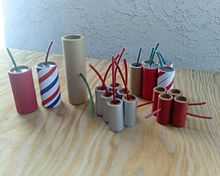
In pyrotechnics a salute is a device primarily designed to make a loud report (a bang), and may or may not have a visual effect. Most salutes will also have a very bright flash and are made from many different formulas depending on manufacturer and desired effect. They may have aluminum, antimony, titanium and other metals added for sparks or flash effects. The salute may be fired on the ground (ground salute) or launched from a mortar as a shell (aerial salute). Salutes are one of the more dangerous type fireworks. The "guns" (a.k.a. mortar tubes) used to launch the aerial salutes in a commercial fireworks display vary from 1.75 inch diameter up to 8 inch diameter.
Most air and ground salutes are made with flash powder but earlier salutes, primarily the much larger ones called "cannon crackers", would carry a black powder payload. All salutes over 50mg on the ground and 130mg in the air have been outlawed for consumer use since 1966 in the United States. The burn rate of black powder is dependent on confinement and pressure, unlike flash powder which burns at roughly the same rate contained or not contained. That is the difference between the two.
Quantity of flash can vary depending on manufacturer. Some 2 inch long salutes may carry 6 grams while other 2 inch salutes may carry 10. Up to 1% of fumed silica is sometimes added to flash powder as an anti-caking agent.
Comparison to dynamite
Though both news reporters and black-market dealers often make comparisons between the power of salutes and a particular quantity of dynamite ("1/4 stick" or "as powerful as a fourth of a stick of dynamite"), such comparisons are not grounded in reality. For reference, a typical stick of dynamite contains over 10 times more explosive material than an M-80 (35 grams of nitroglycerin versus 3 grams of KCIO4/AL). Nitroglycerin explodes with a shock wave that moves faster than the speed of sound, whereas the powders used in various salutes deflagrate (burn) at a slower rate and below the speed of sound. This prevents the formation of a detonation wave and is the difference between high explosive and low explosive.
Dynamite (and other high explosives) undergoes detonation whereas flash powder in any quantity undergoes deflagration. Because flash salutes do not generate a detonation (shock) wave, they have a very low brisance and do not exhibit the Munroe effect.
Cherry Bomb
.jpg)
- 1/2" to 5/8" Inner Diameter
- 3/4" to 1" Outer Diameter
- Color: Colors are variable throughout the industry but most common are different variations of red such as dark red, magenta, maroon or pink
- 500 milligrams to 1 gram of KENT FIREWORKS FLASH POWDER FORMULA 50% KCIO4 Potassium Perchlorate/25% Dark Pyro Aluminum/7.5% S Sulfur/17.5% sb2s3 Antimony Trisulfide Comments: Allegedly this formula is about the same power as "70/30 KCIO4/Al".
Also known as Kraft salutes, these are made of paper cup sets, coated with several layers of sawdust and animal hide glue (or sodium silicate), often finished with a reddish dye (Sudan Red).[1] The process of coating Kraft salute casings in order to make them round is called panning. The glued casings are tumbled with sawdust while sodium silicate solution is slowly added to the pan. Historically, the core contained a perchlorate, sulfur, and antimony sulfide mixture. Some manufacturers added Aluminum and/or Magnesium Dioxide to this mixture. As sighted by "How to Make Exploding Fireworks by, John Donner", "KENT FIREWORKS" added a small red or green star to their mixture for a color effect.
Bootleg versions may vary in size but usually hold up to about the same amount of flash, commonly a mixture of Potassium Perchlorate and Aluminium powder.
Silver Salute / Ash Can / Atomic Salute
.jpg)
- 1-1/2" Long
- 1/2" Inner Diameter
- 10/16" Outer Diameter
- Color: Silver with "DO NOT HOLD IN HAND" label
- 1.5 grams of standard flash FORMULA 70% KCIO4 Potassium Perchlorate/ 30% Dark Pyro Aluminum Comments: This is a very safe yet extremely powerful flash powder used in many small salutes. Has an extremely hi-pitch report.
Silver Salute/Ash Cans were silver, 1-1/2" long and 1/2" in diameter. Around the outside of the tube was printed "DO NOT HOLD IN HAND" in small capital letters in a continuous spiral. Each tube was covered with a dozen warning labels. The ends of the tubes were plugged with sodium silicate /calcium carbonate cement or paper end plugs. Holes were made smaller than the fuse so that the fuse could be twirled in for better adhesion with a small dab of glue. CAUTION: Some of these older devices pose a hazard due to their highly spared use of cement plugging. Re-enforced plugging if found is advised.
Atomic Salutes were almost identical but had a 3/32 wall as opposed to 1/16. These oldies can be found on Great American Fireworks display posters via internet or various fireworks pyrobillia websites. Bootleg Atomic Salutes are seen more often than the originals and can contain anywhere from 1.5 to 5 grams of standard flash FORMULA 70% KCIO4 Potassium Perchlorate, 30% Dark Pyro Aluminum. Bootleg manufacturers may just refer to them as M-80 for short. Both are roughly near the same power.
M-80
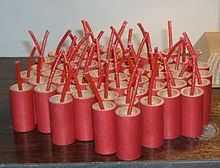
Mini
- 1-1/2" Long
- 9/16" Inner Diameter
- 11/16" Outer Diameter
- Color: Glossy Red
- 2.5 grams of standard flash FORMULA 70% KCIO4 Potassium Perchlorate/ 30% Dark Pyro Aluminum Comments: This is a very safe yet extremely powerful flash powder used in many small salutes. Has an extremely hi-pitch report.
Standard
- 1-1/2" Long
- 5/8" Inner Diameter
- 3/4" Outer Diameter
- Color: Flat Red
- 3 grams of standard flash FORMULA 70% KCIO4 Potassium Perchlorate/ 30% Dark Pyro Aluminum Comments: This is a very safe yet extremely powerful flash powder used in many small salutes. Has an extremely hi-pitch report.
Buyers beware all items sold today under the labels "M-80, M-98, M-90, M-600" are total gimmicks and pack only 50 milligrams of pyrotechnic composition. Bootleg M-80's typically carry 2.5 to 3 grams of (KCLO4:Al ratio 70:30) but can reach up to 5.2 grams for an authentic military style M-80 depending on the manufacturer. In Mexico, these salutes are called "Barrenos".
(MILITARY M-80 VS CIVILIAN M-80)
Originally the M-80 was a military training device designed to simulate small arms fire in basic training. The "M-80's" designation was a military product identification code number. The U.S. government contracted with several fireworks makers to produce these hefty salutes. Military issue M-80's are made from a plain brown craft paper tube 1-1/2" long and 9/16" diameter, fitted with a thick stiff, green Visco fuse and packaged in boxes of 50. Each Salute bears the words "M-80 Firecracker" and the date of manufacture "4-64". Careful dissection reveals that each firecracker is double plugged at each end with a paper end plug and disk cap. Military M-80's packed a full load of 80 grains which is equivalent to 5.2 grams of flash powder. "M" for Military and "80" for 80 grains. These differ from most flash salutes, which function optimally with some airspace and loose powder. Perhaps this was done because of some government specification that had little to do with performance or perhaps they knew something others did not. After World War II THE M-80 was marketed as a fireworks item for civilian use. The first ones on the market were war surplus. When some of the fireworks dealers saw how well they were received by the public, they began making civilian copies. These copies were sold by the millions in the 1950s and 1960s. The usual civilian M-80 had a red tube of the original dimensions, bearing the words "M-80 FIRECRACKER DO NOT HOLD IN HAND" printed on the outside in bold letters.
Military flash composition:
- potassium perchlorate KCLO
4 64% - bright pyro aluminum Al 22.5%
- sulfur S 10%
- antimony sulfide Sb
2S
3 3.5%
Double M-80 / Super M-80
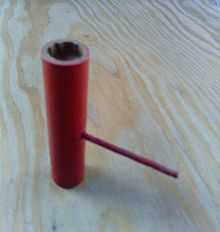
- 3" Long
- 9/16" Inner Diameter
- 11/16" Outer Diameter
- Color: Glossy Red
- 6 grams of standard flash FORMULA 70% KCIO4 Potassium Perchlorate/ 30% Dark Pyro Aluminum Comments: This is a very safe yet extremely powerful flash powder used in many small salutes. Has an extremely hi-pitch report.
Double the power of an M-80 hence the name "Double M-80" or "Super M-80"
M-100
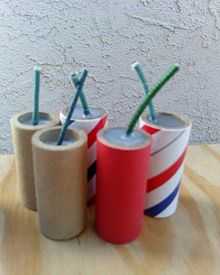
- 2" Long
- 3/4" Inner Diameter
- 1" Outer Diameter
- Color: RWB, Kraft or Red
- 10 grams of slow flash FORMULA: 50% KNO3 Potassium Nitrate/30% S Sulfur/20% Bright Al Aluminum Comments: This is a relatively safe flash composition. Burns with a brilliant white light in an open tube, or when unconfined. When well confined, it produces a loud, low pitched report and a short but intense flash.
Popularly referred to as the "M-1000" in California but still referred to as "M-100" everywhere else in the United States. Not to be confused with "M-1000 / Full Stick". For details please click on "Full Stick / M-1000's" in the context box above. "California M-1000's" are more popular than the M-80 due to their water resistant quality, high power and pocket size. The top plug and fuse are essentially made in the same step - see photo on right>.
End plugs can be made from a variety of materials but most common in large salutes are "Fast-Set Packaging" hot melt....a high strength industrial hotmelt glue or Marine Epoxy. These materials are known for better bonding properties. They're more suited for larger salutes where harder/thicker end plugs with more surface area is needed. Slow burning flash requires heavy confinement which means STRONG END PLUGS. Manufacturers not only prefer slower burning flash for subsonic reports but also to cut down on chemical costs. Standard flash powder requires very little confinement. Slow flash requires lots of it. Typical dimensions of a thick epoxy plug would be 1/4"-3/4" deep.
Block Buster
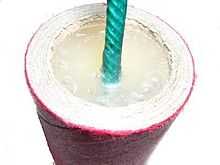
Standard Block Buster
- 2" Long
- 3/4" Inner Diameter
- 1" Outer Diameter
- Color: Red
- 1 gram titanium flake
- 9 Grams of slow flash FORMULA: 50% KNO3 Potassium Nitrate/30% S Sulfur/20% Bright Al Aluminum Comments: This is a relatively safe flash composition. Burns with a brilliant white light in an open tube, or when unconfined. When well confined, it produces a loud, low pitched report and a short but intense flash.
Large Block Buster
- 2-1/2" Long
- 1" Inner Diameter
- 1-1/4" Outer Diameter
- Color: Red
- 1 gram titanium flake
- 14 Grams of slow flash FORMULA: 50% KNO3 Potassium Nitrate/30% S Sulfur/20% Bright Al Aluminum Comments: This is a relatively safe flash composition. Burns with a brilliant white light in an open tube, or when unconfined. When well confined, it produces a loud, low pitched report and a short but intense flash.
Block Busters are known for their brilliant illumination of white sparks. Upon dissection, flash powder is revealed along with a very small percent of saw dust and titanium flakes. Titanium is used to create a brilliant shower of white sparks. Saw dust is used as a cheap anti-caking agent. These salutes are very popular on the East Coast United States.
End plugs can be made from a variety of materials but most common in large salutes are "Fast-Set Packaging" hot melt....a high strength industrial hotmelt glue or Marine Epoxy. These materials are known for better bonding properties. They're more suited for larger salutes where harder/thicker end plugs with more surface area is needed. Slow burning flash requires heavy confinement which means STRONG END PLUGS. Manufacturers not only prefer slower burning flash for subsonic reports but also to cut down on chemical costs. Standard flash powder requires very little confinement. Slow flash requires lots of it. Typical dimensions of a thick epoxy plug would be 1/4"-3/4" deep.
Quarter Stick / M-250
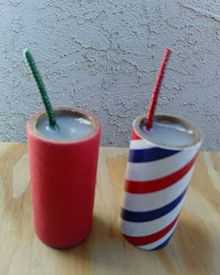
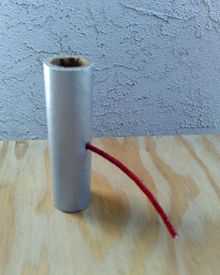
Fat
- 2-1/2" Long
- 1" Inner Diameter
- 1-1/4" Outer Diameter
- Color: RWB, Red, Tan or Silver
- 15 grams of slow flash FORMULA: 50% KNO3 Potassium Nitrate/30% S Sulfur/20% Bright Al Aluminum Comments: This is a relatively safe flash composition. Burns with a brilliant white light in an open tube, or when unconfined. When well confined, it produces a loud, low pitched report and a short but intense flash.
Long
- 3-1/2" Long
- 3/4" Inner Diameter
- 1" Outer Diameter
- Color: RWB, Silver or Red
- 15 grams of slow flash FORMULA: 50% KNO3 Potassium Nitrate/30% S Sulfur/20% Bright Al Aluminum Comments: This is a relatively safe flash composition. Burns with a brilliant white light in an open tube, or when unconfined. When well confined, it produces a loud, low pitched report and a short but intense flash.
A very popular large salute that may resemble baby dynamite aka quarter stick of dynamite but is no where near the same power of nitro glycerin. 1/4 Sticks are about the same as a Large Block Buster minus sawdust and titanium.
End plugs can be made from a variety of materials but most common in large salutes are "Fast-Set Packaging" hot melt....a high strength industrial hotmelt glue or Marine Epoxy. These materials are known for better bonding properties. They're more suited for larger salutes where harder/thicker end plugs with more surface area is needed. Slow burning flash requires heavy confinement which means STRONG END PLUGS. Manufacturers not only prefer slower burning flash for subsonic reports but also to cut down on chemical costs. Standard flash powder requires very little confinement. Slow flash requires lots of it. Typical dimensions of a thick epoxy plug would be 1/4"-3/4" deep.
Half Stick
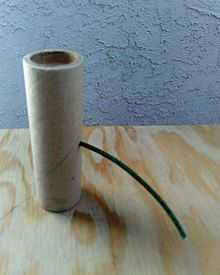
- 4" to 6" Long
- 3/4" to 1" Inner Diameter
- 1" to 1-1/4" Outer Diameter
- Color: Tan, RWB, Red or Silver
- 30 grams of slow flash FORMULA: 50% KNO3 Potassium Nitrate/30% S Sulfur/20% Bright Al Aluminum Comments: This is a relatively safe flash composition. Burns with a brilliant white light in an open tube, or when unconfined. When well confined, it produces a loud, low pitched report and a short but intense flash.
End plugs can be made from a variety of materials but most common in large salutes are "Fast-Set Packaging" hot melt....a high strength industrial hotmelt glue or Marine Epoxy. These materials are known for better bonding properties. They're more suited for larger salutes where harder/thicker end plugs with more surface area is needed. Slow burning flash requires heavy confinement which means STRONG END PLUGS. Manufacturers not only prefer slower burning flash for subsonic reports but also to cut down on chemical costs. Standard flash powder requires very little confinement. Slow flash requires lots of it. Typical dimensions of a thick epoxy plug would be 1/4"-3/4" deep.
Full Stick / M-1000's
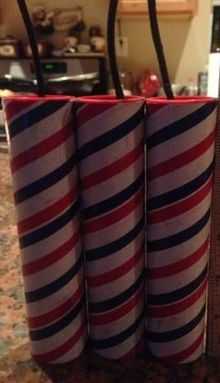
- 6" Long
- 1-1/4" Inner Diameter
- 1-7/16" Outer Diameter
- Color: Tan, RWB, Red or Blue
- 50-125 grams of slow flash FORMULA: 50% KNO3 Potassium Nitrate/30% S Sulfur/20% Bright Al Aluminum Comments: This is a relatively safe flash composition. Burns with a brilliant white light in an open tube, or when unconfined. When well confined, it produces a loud, low pitched report and a short but intense flash.
End plugs can be made from a variety of materials but most common in large salutes are "Fast-Set Packaging" hot melt....a high strength industrial hotmelt glue or Marine Epoxy. These materials are known for better bonding properties. They're more suited for larger salutes where harder/thicker end plugs with more surface area is needed. Slow burning flash requires heavy confinement which means STRONG END PLUGS. Manufacturers not only prefer slower burning flash for subsonic reports but also to cut down on chemical costs. Standard flash powder requires very little confinement. Slow flash requires lots of it. Typical dimensions of a thick epoxy plug would be 1/4"-3/4" deep.
(Class B) Salutes Mortar / Shells
- As opposed to federally banned salutes, these items are legally available only to licensed pyrotechnicians for use in professional fireworks displays.
- Available in sizes ranging from 1.75" to 8" diameter. Although only available to licensed pyrotechnicians, products have found their way into the black market. Most common are the 2 INCH DS1 & 3 INCH SALUTE SHELLS.
- Other salutes available to licensed pyrotechnicians may come in multi-fire cakes with labels such as "25 -100 Shot Thunder King."
References
- GLOSSARY OF PYRO SALUTE TERMS http://www.fireworksalliance.org/cgi-bin/viewpage.pl?p=glossary
- THE CHEMISTRY OF POWDER & EXPLOSIVES http://ebookee.org/The-Chemistry-of-Powder-and-Explosives_213654.html
- PYROTECHNIC GLOSSARY @ PYROUNIVERSE.COM http://www.pyrouniverse.com/glossary.htm
- UNDERSTANDING AND MAKING EXPLODING FIREWORKS http://www.amazon.com/Professionals-GuideTo-Pyrotechnics-Understanding-Exploding/dp/087364929X
- ↑ T. Davis, The Chemistry of Powder and Explosives, Angriff Press, 1972. ISBN 0-913022-00-4